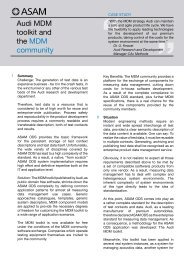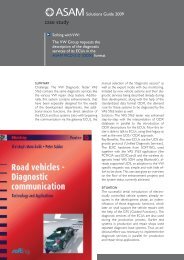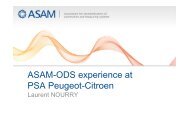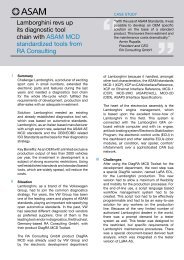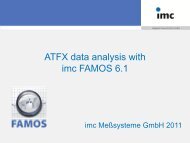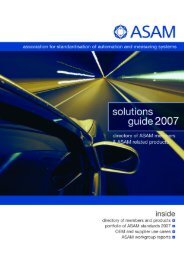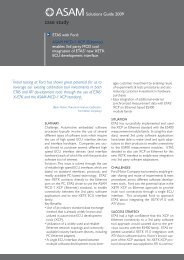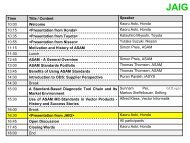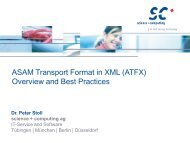Create successful ePaper yourself
Turn your PDF publications into a flip-book with our unique Google optimized e-Paper software.
eports from the workgroups<br />
activity report from<br />
<strong>ASAM</strong> GDI<br />
(Generic Device Interface)<br />
Solutions Guide 2007 SECTION TWO<br />
Description<br />
<strong>ASAM</strong> GDI was developed for the operating<br />
system independent integration of<br />
measurement and control devices into<br />
applications. This standard consists of 4<br />
layers. The higher layer depends on the lower<br />
layer, the lower layer may be used<br />
independent from the higher layer.<br />
Transport Layer Extensions and<br />
Communication Types (Layer 1) are<br />
responsible for the data exchange between<br />
the Platform Adapter and physical devices<br />
connected at peripheral interfaces or between<br />
the Platform Adapter and supporting software<br />
systems. The Transport Layer Extension is an<br />
operating system specific software, which has<br />
to be developed for a standardized access to<br />
all peripheral components. One extension<br />
supports 1 to n Communication Types. For<br />
most common interfaces RS232, IP4 and<br />
USB, Transport Layer Extensions are available<br />
on the market for Windows® and LINUX.<br />
The Platform Adapter (Layer 2) provides a<br />
standardized interface for the resources of the<br />
operating system (cp. POSIX) and routes<br />
communication between Device Drivers and<br />
Transport Layer Extensions. The Platform<br />
Adapter is an operating system specific<br />
software. For Windows® and LINUX, Platform<br />
Adapters are available on the market.<br />
Device Drivers and Device Capability<br />
Description (Layer 3): Device Drivers contain<br />
device specific software for the<br />
communication with devices via the Platform<br />
Adapter. The standardized interface allows a<br />
uniform access to different devices of any<br />
kind. The Device Capability Description (DCD)<br />
is a computer readable data sheet for the<br />
devices handled by a Device Driver. It is a<br />
class description and therefore it is valid for<br />
one or many devices of the same kind. These<br />
devices are called “virtual devices”, because<br />
the view on a device may be defined by an<br />
application and the Device Driver does the<br />
mapping to the real devices. The resources of<br />
a virtual device are again described with<br />
classes, what allows an unlimited number of<br />
equal resources, e.g. based on multiple<br />
channels of real devices. <strong>ASAM</strong> GDI<br />
developed so called Companion Standards,<br />
which define the behaviour of devices for<br />
special applications (Crash Test, Chassis<br />
Dyno, Multi Data Acquisition and Emission<br />
Bench). For such applications only one<br />
standardized capability description (DCD) is<br />
valid for all Device Drivers of different<br />
manufacturers and the goal of the driver is to<br />
make its devices fitting to the application.<br />
Companion Standards make it possible, to<br />
exchange drivers and devices of different<br />
manufacturers with minor or no changes of an<br />
application (Plug-and-Play). For the<br />
integration of ECUs into GDI-based<br />
measurement applications, a Companion<br />
Standard for the use of MCD-3 based<br />
systems was defined.<br />
Coordinator and Parameter Instance<br />
Description (Layer 4): The Coordinator<br />
presents the resources of all used virtual<br />
devices without a link to the devices itself. So<br />
we get a pure application view on<br />
measurement and control values. For the<br />
mapping to devices, a coordinator reads a<br />
Parameter Instance Description (PID), builds<br />
up the resource interface and configures the<br />
periphery accordingly (booting the system).<br />
The PID is derived from DCDs and contains all<br />
instances of devices and resources and the<br />
values for parameters and attributes as<br />
needed by a concrete application. Thus the<br />
PID is a configuration file of an application<br />
used by the Coordinator.<br />
17





